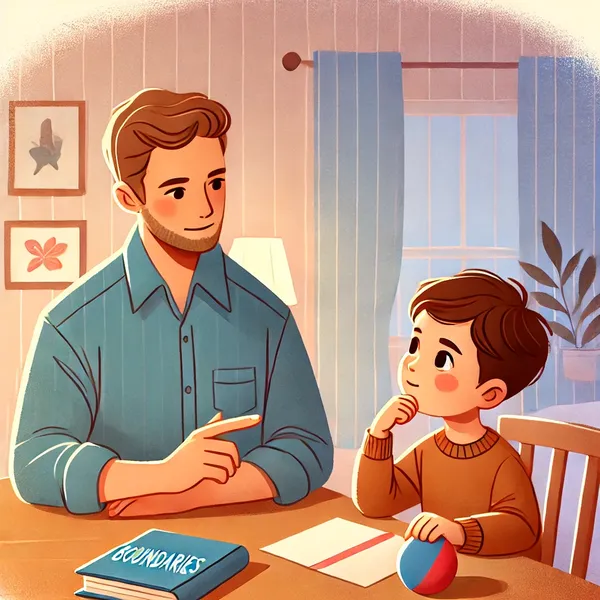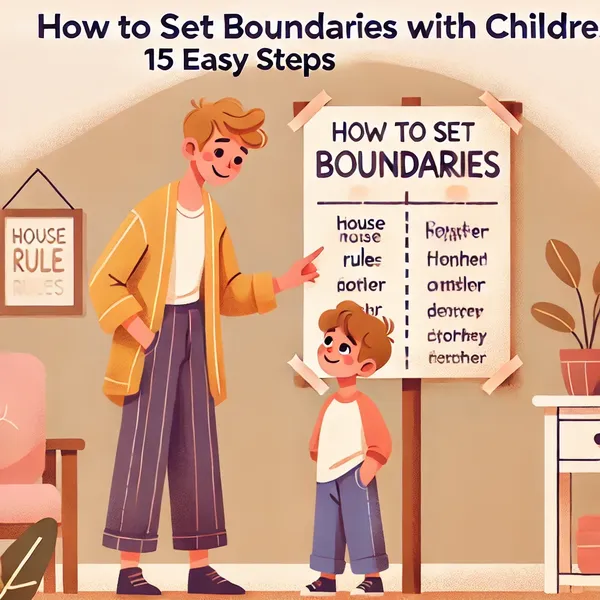How to set boundaries with children? As parents of young children, we want our children to grow up happy and healthy and to show other people the respect they deserve!
Creating boundaries doesn’t just teach children how to follow rules; it also teaches them about the world they live in, self-discipline, and respect, which they will carry into adulthood.
But how about we take the pressure off setting boundaries and make it much more different with a friendlier feel and, most importantly, child-centeredness?
Why Boundaries Matter
Kids need guidelines that clearly state what is “okay” and what is not.
It would be like trying to drive without any traffic lights or stop signs); Like limits help children understand how to behave and make them feel safe and secure.
- Safety: Kids need to know the boundaries for comfort and security.
- Respect: Setting clear boundaries promotes respect from others.
- Freedom: boundaries allow children the space to learn independent action
How to Set Boundaries with Children
Simple Boundaries First

Start with simple limits that children are bound to understand. Simplicity is essential, especially when working with younger children.
For example, “Stay in the yard when playing outside” is a clear, sensible limit that helps maintain safety and authority.
Examples of Simple Boundaries
- Practice every day: Establish daily routines, like “Brush your teeth before sleep,” to develop proper habits.
- Limiting Behavior: “Hitting and yelling at children is not allowed” — respect and empathy.
- My 3’s: Safety Rules, i.e. boundaries like “Hold my hand when crossing the street,” which keeps them safe.
Use Positive Language
Positive instructions work better with children than with restrictions. If you say, “Don’t yell,” use the alternative phrase and tell them using words such as “Indoor voice.”
This method leads them to what they need to do instead of what cannot be done (if at all).
Examples:
- Substitute “Don’t run” with > ‘Stroll, please.’
- Change extends to: Stop interrupting > Wait until your turn to speak
- That shift is slight but calls in for enjoyment, not conflict.
Children should be part of the process.
Let kids help set boundaries. The second is a kid who will follow the rules they helped make.
For example, ask, “Why do you think it is necessary to share toys?” or ” What bedtime do you think this is good to work with?”
Benefits of Involving Kids
- Accountability: They learn to take responsibility.
- Comprehension: They understand the logic behind everything discussed.
- Respect: They are seen and heard in a way that increases their cooperativeness
Be Consistent

An effective boundary has the same consistency as your backbone. Now, what if the parents set a rule that changed daily?
How many instances do you think children may follow through? Consistency breeds trust, and everyone better knows what to expect.
How to Stay Consistent
Follow-through: Parents should gently remind children of the rules every time they attempt to push boundaries until they become habits.
Be Consistent: Follow through on setting the rules from day one, even when it may be difficult!
Unite: Therefore, ensure all caregivers are on the same page regarding boundaries and work together so conflicting information is not sent to your troubled teen.
Offer Choices Within Boundaries

When free from parents, children are independent-minded—down to refusing a wet wipe and wanting their friend or sister to rub hair out of their eyes.
You can show this by offering them choices within a set parameter. Instead of telling them to eat their vegetables, ask, “Which would you prefer…carrots or peas?”
An Example of Choice in the boundary
Example: “Would you like an apple or banana for snack time?”
- Choice of Clothing: Red shirt or Green?
- “Play outside or do a puzzle?
- You respect that they have a mind, yet you remain in control.
Establishing Boundaries Appropriate for Age.
She also explains that boundaries should be dynamic and change as your child does. By setting rules that are for their age, both logic and grasping are followed, helping them to be more intelligent.
Saying yes to letting a 3-year-old choose what they want to wear is fine, but asking that same toddler when he/she wants their bedtime should not be done.
Age-Specific Boundaries
Toddlers: Remember to focus on safety and light routines, as they are too young for complex sentences. For example, “Pick your toys.”
- Elementary Age: “Do homework before turning on screens.”
- Teens: Focus on honour and objectives like “Aim to let me know if you’re going to be late.”
- Boundaries will change as they grow — adapt based on the stage.
The Why of Boundaries Explained
Kids, especially as they get older, ask WHY all the time. Instead of telling them, “Because I said so,” explain why you are requesting this or making this rule.
Examples:
- “We clean hands before supper as we eat germs.
- You must go to bed at 8 to wake up early for school.
- They will be more likely to adhere if they understand the why.
Lead by Example
Kids learn by what they see more than what you say. Rules are rules, even for yourself. For example, if you have a no phones at the dinner table rule, follow it yourself.
Modelling Boundaries
- RESPECT: Ask them to be respectful in their word choice, and you should mirror respectful wording.
- Keep your cool: demonstrate a sense of calmness, especially during moments of conflict.
- Establish Rules: Respect the limits that you demand—demonstrate honesty.
This then naturally reinforces the boundaries, and kids will begin to respond in kind because they have been inspired by your actions!
Consequences that are gentle and clear
Consequences help reinforce boundaries, and they do not have to be harsh. Our goal is not to deter but to direct. Warn kids of the consequences and make them explicit.
Types of Gentle Consequences
- Privileges: “If you hit your brother, the toys will disappear.”
- Practice TIME IN: Rather than using a time-out, discuss why it was not all right.
- Solution-based: they are their own best cleanup crew if things go awry.
Stop treating consequences as punishment. Let them be learning instead.
Praise Positive Behavior
Take time to celebrate and honor their respect for boundaries. Good job praise is doubly motivating with kids.
What Positive Reinforcement Might Look Like
- “Thank you for waiting to speak. That was very respectful!”
- ” And You did well cleaning up your mess. I appreciate it!”
- “You listened so well today. I’m proud of you!”
It will also help boost his self-esteem and develop good habits with positive feedback.
Flexibility is Key
Boundaries Need To Be Set — But Like Landmines Every so often, the world shifts on you, and you need to break your own rules.
For example, if there are valid reasons or your child is overworked (around exam time for a junior high schooler), you may decide this battle can be avoided one night.
When to Be Flexible
Play Dates: Maybe the kids are seeing neighbours and deserve to stay up; Family Gatherings or Parties Special Occasions (ex., Birthdays, Holidays): This may extend bedtime for a night
- Illness: Drop their walls so they can feel safe
- Needs for Mind: Initially, a rough day requires additional patience.
It teaches kids that rules are essential. However, kindness and flexibility are also crucial.
Remain Composed While Testing Boundaries
Children constantly challenge boundaries—it is how they learn and progress. At these times, it is essential to remain calm.
Yelling or even bringing it up when you overreact only sends mixed messages. Instead, breathe and tell yourself that testing is routine.
Best Boundary Testing Practices
- POV: centre yourself before you act
- Neutral: Composure. Your tone remains unchanged; they can tell you are not rattled.
- Repeat the Rule: Directly and calmly tell them the reason for that boundary.
Patience at these times is essential to enforce boundaries without resulting in a battle.
Understand the Long-Term Consequences of your Boundaries
For the first time, boundaries set now can pave the way for a positive future. Skills like this follow children into adulthood, allowing them to establish positive relationships and excel in their academic endeavours and later careers.
Lasting Effects of Boundaries
- Regulation of Emotions: Boundaries teach kids how to manage their emotions.
- Making the Decision: Clear boundaries help them make better decisions.
- Respect for Others: They understand the boundaries of the facility staff.
Fostering Open Communication
Boundaries are not just for showing others what is and is not okay but also for giving us a way of communicating. Encourage your child to express his/her feelings about boundaries. Hear what they are saying and be ready to talk about it.
Conversation Starters:
You may ask, “What was it like to get ready for bed every night as a child?”
- How do you feel about sharing toys?
- “Any question you would like to ask.”
This allows them to feel comfortable expressing themselves and gives you insight into their mind.
Conclusion
But this doesn’t mean we must be rigid and strict in setting boundaries with children. It is about leading them in a manner that makes them feel safe, supported, and empowered.
By having clear expectations and enforcing those with consistency and gentle flexibility, you can help them respect the rules AND take responsibility for their independence.
After all, boundaries are not just walls or limitations; they’re gifts of guidance and love. When put in place intentionally, they cultivate children who can learn and respect boundaries.
This essay empowers readers to make boundaries feel good–through bolded words, lists and friendly conversation.


